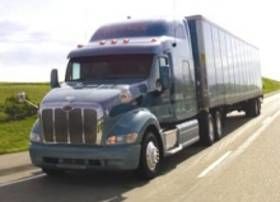Review Questions - Click On The Picture To Begin...

- Slow down before entering the curve as to avoid braking or shifting during the curve
- Depress the clutch pedal and coast through the turn
- Continue to slow down throughout the entire duration of the curve
- Continue slowing down during the curve, and downshift about half way through the curve
Quote From The CDL Manual:
When approaching a curve:
- Check traffic thoroughly in all directions.
- Before entering the curve, reduce speed so further braking or shifting is not required in the curve.
- Keep vehicle in the lane.
- Continue checking traffic in all directions.
TruckingTruth's Advice:
Always slow down and get into the correct gear before the curve and never shift during the curve. It's better to slow down too much than not enough.
- Be sure you're not blocking any road signs
- Set the trailer brakes only
- Place the truck into a low gear before releasing the clutch
- Keep the right turn signal activated
Quote From The CDL Manual:
Once stopped:
- Vehicle must be parallel to the curb or shoulder of the road and safely out of the traffic flow.
- Vehicle should not be blocking driveways, fire hydrants, intersections, signs, etc.
- Cancel the turn signal.
- Activate the four-way emergency flashers.
- Apply the parking brake.
- Move the gear shift to neutral or park.
- Remove your feet from the brake and clutch pedals.
- Bring your vehicle to a full stop without coasting
- Decelerate quickly without changing gears
- Leave the truck in gear, but depress the clutch pedal to avoid stalling while slowing down
- Place the transmission in neutral before braking
Quote From The CDL Manual:
As you prepare for the stop:
- Check traffic.
- Activate your right turn signal.
- Decelerate smoothly, brake evenly, change gears as necessary.
- Bring your vehicle to a full stop without coasting.
TruckingTruth's Advice:
Always slow down smoothly and use downshifting to slow the vehicle. You never want to be out of gear or leave the clutch pedal depressed while slowing down.
- For approximately 30 seconds after re-entering traffic flow
- Before rolling forward to re-enter the traffic flow
- After you have re-entered the traffic lane
- Once you are in the traffic lane and up to highway speeds
Quote From The CDL Manual:
When instructed to resume:
- Check traffic and mirrors thoroughly in all directions.
- Turn off the four-way flashers.
- Activate the left turn signal.
- When traffic permits, release the parking brake and pull straight ahead.
- Do not turn the wheel before your vehicle moves.
- Check traffic from all directions, especially to the left.
- Steer and accelerate smoothly into the proper lane when safe to do so.
- Once your vehicle is back into the flow of traffic, cancel the left turn signal.
TruckingTruth's Advice:
Before you begin moving forward, you should activate the left turn signal so other motorists know you're getting ready to re-enter the traffic lane.
- Use proper signals
- Make necessary traffic checks
- Change lanes when it is safe to do so
- All of these answers are true
Quote From The CDL Manual:
You will be instructed to change lanes:
- Make necessary traffic checks.
- Use proper signals.
- Change lanes smoothly when it is safe to do so.
TruckingTruth's Advice:
The examiner will ask you to make a lane change, but you're expected to perform the lane change safely. The examiner will not check for traffic before asking you to make the lane change.








 TT On Facebook
TT On Facebook